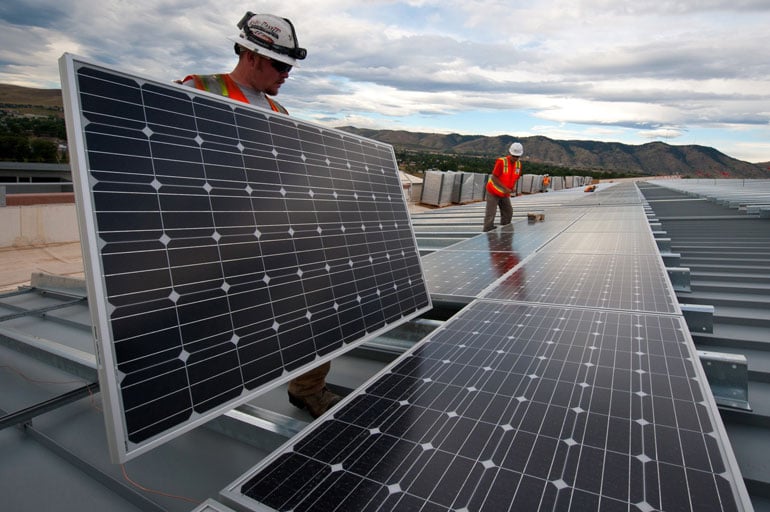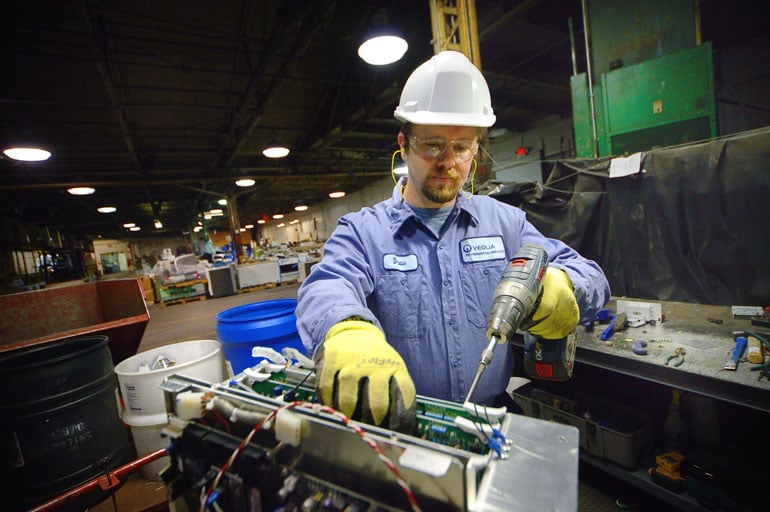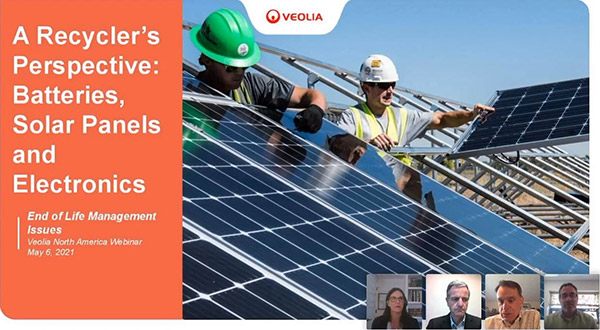We’ve turned a corner for green energy. The growth in demand for solar panels and lithium ion batteries has skyrocketed and continues to expand. The energy generated by solar panels alone increased over 2.5 times, from 7,509 MWp (megawatt peak) in 2015 to 19,221 MWp in 2020. The turn towards renewable energy sources is a leap forward in building a circular economy and a sustainable future.
The question is, how do we deal with the waste that green energy technologies create? What are your recycling options, and why should you recycle? This post will address these questions and more.
The other side of green energy
When people think of renewable power, they think clean, natural, sunlight, wind, and water. We’re simply utilizing the massive amounts of energy found in nature in seemingly infinite quantities. The other side of the equation is that it takes technology to harness that power. Sunlight by itself doesn’t give us electricity. We need to build systems that take the sunlight and convert it into something we can use. While the availability of sunlight may be infinite, any of the systems manufactured by humans to support the distribution of solar power are not.
Solar panels, batteries, and other electronics have finite lifespans. Once they’ve reached their end of life, many companies are tempted to simply throw them away in landfills. However, doing so is detrimental to the environment, wasteful of valuable resources, and often may defeat the purpose of choosing renewable energy sources in the first place. In addition, there may be large fines incurred for violating recycling regulations.
Why recycle solar panels, batteries, and electronics
The resources that go into creating solar panels, batteries, and other electronics are not unlimited and require energy and effort to acquire. In addition, they often have more value to give beyond the service life of the system they are a part of. For example, the metal in both solar panels and batteries can be recycled and used again, even when the panels and batteries are at the end of their useful lives.
Discarding electronics “waste” effectively extinguishes the additional value that the waste could provide. On the other hand, by recycling this waste, materials that would otherwise become solid waste are being converted into valuable resources that can serve as feedstocks or building materials for new products.
By taking the “waste” from something that is at the end of its useful life and converting it into a resource for another item, we get closer to closed loop, sustainable energy and manufacturing solutions. The process brings us closer and closer to building a circular economy.
Electronics recycling reduces dependence on new resources
In addition to extracting additional value from existing resources, recycling solar panels, lithium batteries, and other electronics lessens our need for new resources. Mining and metal production can create extensive environmental impacts that are often negative. By recycling materials like copper, silver, gold, palladium, and aluminum, we can reduce our mining efforts further for future industrial and energy processes.
How to recycle solar panels
Solar panels are made up of glass, metal, and plastic — all of which can be used again once the panel has reached its end of life. Recycling solar panels starts with separating and isolating all the constituent components, including the special photovoltaic panel glass, aluminum frame, connection box, and connection cables.

The process begins by removing the aluminum frame and the electric modules and cables from the panel glass. The glass is then fed into a machine that cuts the panel into small pieces that are ground and sifted to remove any metal. An optical sorting system ensures that only pure glass remains at the end of the process.
Once recovered, all the materials can be sent to various industrial sectors:
- Glass is used to create new glass
- Aluminum frame is sent to an aluminum manufacturing plant
- Plastics are used as fuel in cement production
- Silicon wafers can be melted and used by specialty recycling companies
- Cables and connectors are sold as copper scrap to be recycled
How to recycle lithium batteries
Similar to solar panels, recycling lithium batteries involves extracting their individual components. The battery cell itself is shredded and separated until you have a sludgy mixture of lithium, manganese, cobalt, and nickel called “black mass.” Those metals are then recovered from the black mass and refined to be used in new batteries. The plastic from the battery can be used in cement production, while any aluminum or copper can be sold and reused.
Recycling lithium batteries takes place in five steps:
- Batteries are received and dismantled
- The cells are extracted from the battery module
- A machine shreds the cells
- The remains are fed into a separator to segregate the paper and plastic, metal scraps, and the black mass
- Those recovered materials are reused in new batteries or other industrial processes
How to recycle electronic equipment
Recycling electronic equipment also involves the separation and recovery of the materials that the various components are made of. Electronics are dismantled and separated using either automated machines or manual processes. The individual parts are then shredded into small pieces, and magnets remove ferrous metals like steel. Electronic currents, near infrared light and density separation methods are used to remove other metals and plastics.

Those materials are then put to further use. Mixed plastics can be used to substitute for aggregate in concrete or can be used as fuel in concrete production. Sorted plastics can be recycled into pellets for extrusion or into pellets for new products. And metals can be extracted, sorted by grade, and shipped to a smelter for recovery and reuse.
Many electronics contain hazardous and potentially harmful substances, so properly recycling them is crucial to preventing environmental harm. Fluorescent and mercury lamps, for example, can be disassembled and reused to avoid landfills. The lamp’s components are crushed and separated into glass, metal, and phosphor powder. The metal and glass are sold and repurposed, while the phosphor powder is distilled to recover mercury that can be used again.
Regulatory issues
There are several regulations that include requirements that affect how solar panel, lithium battery, and electronics waste may be disposed of.
The Resource Conservation Recovery Act
The Resource Conservation Recovery Act (RCRA) of 1976 is the law that created the framework for managing hazardous and non hazardous waste. It authorizes the Environmental Protection Agency (EPA) to control hazardous waste from its initial development through its lifecycle, to its final disposal, from “cradle to grave.”
Under RCRA it is illegal to dispose of hazardous materials as a solid waste. Accordingly, some components in spent solar panels, batteries, mercury containing lamps, computers and electronics may be categorized as hazardous waste. Fines for environmental noncompliance can be up to $74,552 per occurrence per day.
Comprehensive Environmental Response, Compensation, and Liability Act
The Comprehensive Environmental Response, Compensation, and Liability Act (CERCLA) of 1980 established a program for the investigation and cleanup of facilities that released any hazardous waste substance into the environment. Initially funded through a ‘Superfund’ tax, the legal and financial liability is “cradle to grave”: the liability exists as long as the waste, like a circuit board or lamp, remains.
Under CERCLA the liability is strict and is imposed in the absence of fault, knowledge, intent, negligence, breach of contract, or any other direct or indirect wrongdoing by the person held responsible. The superfund liability is “joint and several”: each party involved is individually liable for the entire cost of cleanup. Under the Superfund law, no contract, indemnification or any other agreement among the parties can remove this potential liability from any of the parties, and there is no small quantity exemption from the liability.
Recycling lithium batteries, solar panels, and electronics is a way to reduce environmental impact and the need for new resources. On the other hand, there are strict penalties for not disposing of them properly.
Why should you recycle?
In order to build a sustainable future, the options can’t be viewed solely on an economic basis. Recycling can be more expensive. As an example, solar panels cost about one dollar to toss in a landfill and about 20 dollars to recycle. So why recycle?
The answer is because it is the right thing to do, morally, ethically, environmentally and, possibly, legally. If you add your solar panels to a landfill at the end of their life, then you’re adding to pollution, putting a further strain on limited resources, and offsetting some of the good you did by switching to solar.
Recycling, recovery, beneficial reuse, waste to energy — these are the management methods that will help bring about the circular economy. Avoiding these methods now potentially means regulatory fines in the short run and much larger, more serious costs for the planet moving forward.



